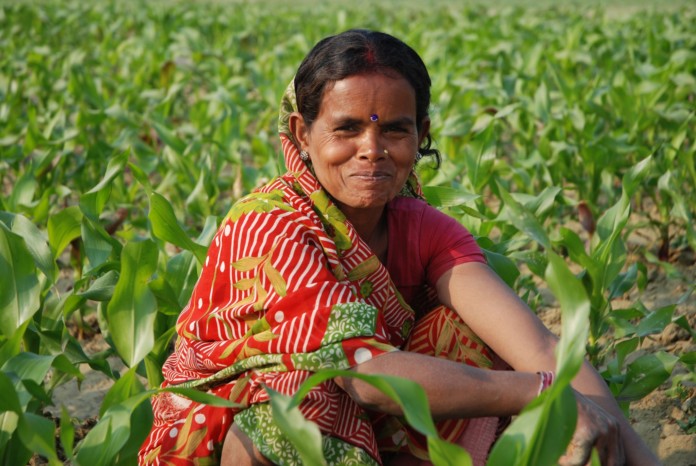For a long time there’s been a sense of despondency about India’s ability to address critical challenges facing its agriculture sector despite loud statements of sympathy and half-hearted measures. Last ten years has seen climate change destabilizing the already weak system. To add to it, the central government’s demonetization policy in 2016 sucked up vital cash while policies towards cattle made their condition even worse.
In 2014 the Delhi-based Syngenta Foundation came up with the idea of creating and nurturing an army of agriculture entrepreneurs (AEs) in 2014 with the belief that only an entrepreneurial approach has the best chance of improving the lives of the small farmer. In five years, it has close to 2,000 AEs, a quarter of them women, serving more than 2,00,000 farmers across Andhra Pradesh, Bihar, Jharkhand, Madhya Pradesh, Maharashtra and Odisha.
The AE model is an entrepreneur-centric approach to address bottom-line problems of the marginal agrarian community. Every AE works with 150-200 farmers in a cluster of 2-3 villages and acts as a one- stop resource provider for the agricultural needs of small and marginal farmers.
Emboldened by its success the Foundation formed a new company called AEG Foundation – a joint venture between Syngenta Foundation India and the Tata Trusts recently. The Foundation has an ambitious plan to develop 100,000 AEs over the next five years and help 20 million small holder farmers in India.
Five years is also a good time to introspect. With the help of the Global Alliance for Mass Entrepreneurship (GAME), set up in 2018 by Ravi Venkatesan, Madan Padaki and Mekin Maheshwari, the Syngenta Foundation published the Agriculture Entrepreneurship Performance Study. The study looks at the factors influencing the performance of the nearly 2000 AEs and what needs to be done to enhance their effectiveness and impact.
The report was authored by Parikrama Chowdhry.
Broad Findings
- The AE initiative has demonstrated significant benefits for small farmers as well as rural youth both economically and socially.
- The AEs are delivering impact while running their businesses, thus making this model easy to scale due to its self-sustaining nature and reduced dependency on continuous external capital infusion.
- The performance of AEs had direct correlation with their education levels.
- Those who treated this as one of their activities performed less effectively than those who gave most of their time to it.
Learnings
A few immediate steps that can be taken to help AEs perform better and scale-up the program are collaborations with market off-takers, creating unique financial products to support ease of credit access to first time entrepreneurs, bringing in mentors with a diverse set of expertise and regularizing refresher trainings for the AEs. Along with that, promoting asset-light quick time-to-market is key for helping AEs achieve an early success is important for them to run a sustainable business.
Larger tie-ups and partnerships are critical for creating a route to a systemic change. Collaborations with entities such as Indian Institute of Entrepreneurship to create a network of trainers along with curriculum interventions in diploma program for pushing entrepreneurship institutionally can be taken up. Schemes such as ASPIRE under the Ministry of Micro, Small and Medium Enterprises remains an unexplored area and it can be of value to partner with existing Livelihood Business Incubators (LIBs).
Input services is seen as the most remunerative services offered by AEs. . It is seen that Agri-Input services are provided by 36% of the AEs across all performance groups. These maybe supplemented with other services such as Market Linkage (16%) and Nursery Management (15%). A lower adoption of Market Linkage however is a significant challenge. A majority of Fast Climbers cited lack of Market Linkage as a challenge faced by them to further scale-up.
Only 18% of the AEs reported being completely dependent on the AE enterprise for their total income generation. Around 60% are able to generate more than 50% of their household income from avenues other than their enterprise. However a larger dependency on the AE Enterprise Program for income is seen to drive higher performance. A very small number of AEs reported having accessed formal loan for their business and in this context providing financial support in terms of seed money as a revolving fund or other unique products can help in giving their business an impetus.
Mentorship being a key factor determining AE performance warrants the need to focus on bringing in diversity in knowledge through AEMs and also a focus on equipping AEMs with the best available technologies and information. This will result in a diversified portfolio of the AEs leading to better performance.
Additionally, AEMs with core expertise such as veterinary, poultry, agronomy, should regularly be asked to share knowledge with other AEMs across project locations. The strength of the model lies in continuous handholding for AEs and the knowledge that an AE is able to pass-on to the farmers.
Continuous evaluations will reveal a deeper understanding of AEs and their role as levers for creating a systemic change in Indian agriculture.
Read full report here
https://massentrepreneurship.org/wp-content/uploads/2019/12/Final-Agri-Entrepreneur-Study.pdf










